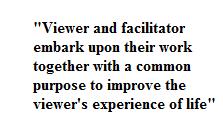This article originally appeared in the TIR Association Newsletter Vol. 2, No. 2 (April 1999)
Rapport, that most precious commodity for anyone working with clients in order to help them, builds upon two factors. One we might call “doing nothing” and the other, “doing something”.
Our caring, receptive presence, the “doing nothing” factor, is deceptively simple. What could be easier than just being there with another person without doing anything? Many things, it seems. It takes training, discipline and a fair degree of ego strength to hold a position quietly and calmly while being purely receptive to another human being without attempting to add to or change the other person’s experience in any way. This is the bedrock skill of person-centered work. (Rachel Naomi Remen expresses this eloquently in the essay, “Just Listen”, to be found in her book Kitchen Table Wisdom.)
To be fully present to another human being requires us to shift our interest and attention from ourselves and our own experience of the world in order to give that interest and attention to someone. Feeling defensive, inadequate, superior, self-absorbed or indeed, any attitude at all, subtracts from our ability to be present in a purely receptive state.
All of us are living, interactive and social creatures. We have thoughts and opinions and we like to make ourselves known by expressing our views. In order to best help our clients in the context of person-centered work we do something very special. We set aside our natural impulses to respond to the world in favor of giving our sole attention and interest to another person for a period of time. You may see this as a natural human ability as many people employ it instinctively in times of crisis; however, maintaining this focus of interest and attention for considerable periods of time on a regular basis needs to be developed. To be fully present and receptive to another person for as long as needed we need to be able to draw upon a “well of stillness” we might say. That the reason why trainers encouraging the practice of Communication Exercises (as taught in the various workshops), as they help to “deepen the well”.
When a client comes to us for the first time, we listen to his concerns and issues. (For simplicity’s sake in this article, a client will be “he” and a facilitator “she”.) As the viewer is heard and understood they begin to relax into the session. As the facilitator listens, acknowledges and asks questions to further understand, they build rapport between themself and the client. The viewer does their share in the rapport-building process by sharing details of his life situation.
Some viewers settle in to rapport quickly while others, especially if they have had rough experiences in therapy or counseling before, may take more time. It is the facilitator’s job to give the client tasks (viewing instructions) in the session which they can willingly and successfully accomplish. This may include making use of some lighter gradient techniques to give the client confidence in the method, as well as trust in the facilitator.
A viewer is engaged in the session when they are willing and able to talk to the facilitator, to follow viewing instructions, and to look inward as needed for the work to progress. Anything, that interrupts a client’s engagement in the session, must be addressed before any other action is attempted. If communication has broken down between viewer and facilitator, even subtly, the viewer will be less able to work well in the session. To maintain and improve the engagement of the viewer in the session, the facilitator needs to do two things: ensure excellent communication between themself and the viewer, and provide useful ways in which to work.
It’s important to note that the client may be grappling with something difficult to face and still be deeply engaged in the work of the session. Facilitators new to the viewing method sometimes mistake strong emotion on the viewer’s part as a sign that the session has gone awry. Likewise, a new facilitator may become so caught up in the steps of the technique that they fail to recognize signs of lessening engagement in the client which require the facilitator to stop what they is doing and repair the session itself.

Viewer and facilitator embark upon their work together with a common purpose: to improve the viewer’s experience of life and to improve ability to handle life in a way satisfactory to. Nothing builds their rapport like a series of successes. One of the beauties of the viewing method is that success is built in. From the client’s point of view, their successful completion of each instruction is acknowledged, an accumulation of many little successes. Completion of the instructions, which comprise a technique such as Traumatic Incident Reduction, leads to an end point (the point in which a viewing action is complete). The accumulation of many end points on a variety of subjects and techniques build toward major insights for the viewer, which in turn culminate in observable positive changes in the viewer’s life.
